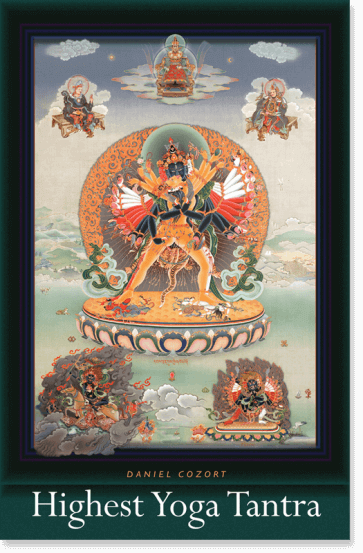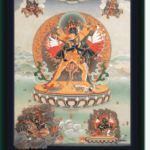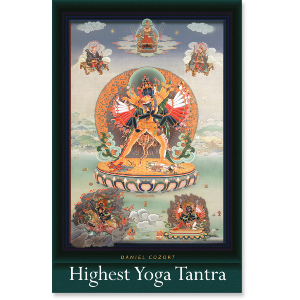| The following article is from the Winter, 1995 issue of the Snow Lion Newsletter and is for historical reference only. You can see this in context of the original newsletter here. |
by Daniel Cozort
To give you a feel for Highest Yoga Tantra, the have included the following excerpt from Part 3, The Six Levels of the Stage of Completion.

The four Joys are bliss consciousnesses generated because of the melting of the drop and its movement in the central channel. In order of least to greatest, they are called joy, supreme joy, special joy, and innate joy. There are various other ways of distinguishing the joys. For instance, in the context of physical isolation, the joys generated by the descent of the drop from the top of the head are distinguished from those generated by the ascent of the drop from the secret lace at the base of the spine. The joys generated from the ascent of the drop are much more powerful than those generated from the descent of the drop; all of the joys from the ascent of the drop are considered innate joys, the type with the greatest intensity.
Thus, although there are said to be four joys from above and four joys from below, the joys from above and from below are not necessarily the fourjoy, supreme joy, special joy, and innate joysince the four from below are all innate joys. Rather, the four joys above and below are posited not according to the intensity of bliss, but according to the movement of the drops in the central channel. The four joys from above are generated respectively when the white drop flows down from the crown to the throat, from there to the heart, from there to the navel, and from there to the base of the spine. The four joys from below are generated respectively when the red drop rises from the base of the spine to the navel, from there to the heart, from there to the throat, and from there to the crown.
On the path, when the four joys are produced as a result of the entry and dissolution of winds in the central channel, they are also often called the four empties. Many scholars follow the explanation that the four joys simply are the four empties. Their assumption probably is that the-emptiessubtle consciousnesses that occur when the winds are with drawnand the joyssubtle bliss consciousnesses that occur when the winds are withdrawnare in fact the same consciousnesses described from different perspectives. Nga-wang-bel-den disagrees, citing Dzong-ka-ba's refusal to equate the four empties and the four joys, as well as Dzong-ka-ba's approval of the explanation by Tup-ba-bel (thub pa dpal) that the four empties are also generated during the white drop's traversal of the sexual organ. Moreover, the four empties could not be identical to the four joys simply because at the time of death there is no experience of the joys whereas there is experience of the empties.
Meditation on Emptiness with Bliss
In the first phase of meditation on the level of physical isolation, one visualized the subtle drop filled with the array of visualized deities and the divine mansion; this caused the winds to enter, remain, and dissolve in the central channel, the Fierce Woman to be ignited, the drops to flow, and great bliss to be engendered. Now, once that has occurred, one is to associate the four joys and emptiness as subject and object in meditative equipoise. In other words, one is to use the blissful consciousness that has been created to realize emptiness. At this point in the meditation, one begins to practice the aspects of physical isolation called mental bliss, bliss of pliancy, and the one-pointed meditative stabilization, three different aspects of one consciousness meditating on emptiness within the force of great bliss. (These aspects are not distinguished with precision in Nga-wang-bel-den's text.) Deities do not appear to this bliss consciousness, but because it is generated due to much previous visualization of deities, its three aspects of bliss, pliancy, and meditative stabilization are still considered instances of deity yoga. For the same reason, even though those three aspects would not fit the etymology of physical isolation because they do not involve isolation from ordinary appearances by substituting ideal appearances, they are still considered physical isolations.

Viewing Appearances As Bliss and Emptiness
After having used the bliss consciousness to realize emptiness, it is said that one should remember bliss and emptiness, restraining all other mental activities so that whatever appears seems to be a manifestation of bliss and emptiness. As Dzong-ka-ba says:
An internal objecta special physical tangible objectis produced through melting the mind of enlightenment by means of a method of penetrative focusing on important places on and in the body. That serves as the observed-object condition whereby a special blissful feeling of the body con sciousness is generated. That [special blissful feel ing] acts as an immediately preceding condition whereby the mental consciousness is generated as an entity of marvelous bliss. At that time, through remembering the meaning of suchness that has already been ascertained, emptiness and bliss are associated.
The dripping of the white drop in the central channel produces an extraordinarily blissful body consciousness, which in turn produces a blissful mental consciousness. Then, with the recollection of emptiness, bliss and empti ness are associated.
The restraint of other mental activities so that everything will appear to be a manifestation of bliss and emptiness is the practice of withdrawal, probably so-called because manifestations of bliss and emptiness appear to the sixth consciousness, the mental consciousness, dominating the sense consciousnesses and causing them to withdraw. Through withdrawal, one's mind is so permeated with a feeling of bliss that all appearances are strongly affected. Concurrently, recollection of meditation on emptiness makes phenomena appear to be light, ephemeral, and like illusions. Everything appears to be sealed with bliss and emptiness.
This type of imagination is a similitude of a Buddha's actual mode of perceiving phenomena at all times. To Buddhas, phenomena are always sealed with bliss and emptiness. This means that there is a sense in which a conscious ness viewing the world as sealed with bliss and emptiness is not faulty, not contradicted by valid cognition.
The practice of withdrawal is essentially a matter of continuing a visualization begun on the stage of generation, when one imagined the world to be a manifestation of bliss and emptiness. However, the same practice on the stage of completion is much more powerful due to the force of one's experience, the immense infusion of bliss that one has experienced as a result of wind and heat yogas.
There are two, more difficult, variations on the practice of withdrawal, one called individual investigation and the other called analysis. In individual investigation, one mentally divides all of the phenomena of the world into the twenty types of gross objects, and then sees them all not only as manifestations of bliss and emptiness, but as taking on either the specific form of a single deity, Vajradhara, or the forms of five deities. It is called investigation because it investigates the entity of the deity inasmuch as it sees that the deity is an expression of bliss and emptiness. One pretends that the mind realizing emptiness appears as the twenty types of gross objects, which in turn appear as either Vajradhara or as five deities.
Analysis is similar to individual investigation but is much more demanding. In analysis, one mentally divides the twenty gross objects into one hundred objects and then visualizes them as twenty deities each of which have five lineages (of the Buddhas Vairochana, Akshobhya, Amoghasiddhi, Amitabha, and Ratnasambhava). The practice is called analysis because it analyzes in detail the specific features of the deities.
Deities. The deities which are vividly visualized in tantric meditation are the imagined forms of various Buddhas who appear either as Buddhas or as Bodhisattvas of high rank. Bodhisattvas are beings who have generated the altruistic aspiration to attain Buddhahood for the welfare of others. Those of high rank are well advanced on the Bodhisattva grounds, which is to say that they have acquired many of the abilities of Buddhas though not in the full measure of Buddhas. Since it is recognized that both Buddhas and high rank Bodhisattvas have the ability to emanate to sentient beings in any manner that will be helpful, even as ordinary objects that people unthinkingly pass over in their daily routines, it is permissible to imagine these enlightened beings in any conceivable form.
However, in practice, tantric manuals prescribe a certain number of deities (for instance, thirty-two in Guhyasamaja) and describe them in varying degrees of detail. The purpose of those descriptions is to assist the meditator, who must attempt to construct a mental picture of the mandala for visualization practice, although such a person will probably also be assisted by a painting (such as the Tibetan tangga [thang ka]) which has been drawn and colored to match the description.
A tantra is usually named after its principal deity. The tantra that is the basis for Nga-wang-bel-den's text, the Guhyasamaja Tantra, has Guhyasamaja, one of the many emanated forms of the Buddha Akshobhya, as its principal deity. Although there are thirty-two deities in the mandala, they are all, in fact, held to be emanations of Guhyasamaja. In a detailed manual for the practice of a particular tantraits means of achievementthere would be a precise depiction of the position, posture, color, ornaments, and so forth, of Guhyasamaja, his consort, and the other deities in the Guhyasamaja mandala, as well as all the features of their environment.
The manual also sometimes contains a lengthy discussion of the symbolic significance of all the details mentioned in the description, aimed at enhancing one's development of divine pride, the sense that one actually is the deity one imagines. For instance, in the water initiation portion of the Kalachakra initiations for the stage of generation, the manual correlates the five seed syllables of the mantra to the five symbols into which they are transformed, five deities with their consorts, the deities that appear on their crowns, and the elements, such as space, wind, and fire, that are cleansed.
Some deities are depicted as being peaceful whereas others are shown to be fierce, hi both cases, the tantric iconography symbolizes a union of bliss and emptiness. For example, the fierce deity Chakrasamvara holds a skull filled with blood, but the skull symbolizes bliss (because bliss is experienced when the white drop at the crown of the head is melted) and the blood symbolizes the mind realizing emptiness.
The deities imagined in meditation are, in one sense, recognized to be products of the imagination; hence, yogis engaged in deity yoga do not have wrong consciousnesses, i.e., awarenesses, such as an eye consciousness mistaking a distant pillar for a man, that are incorrect with regard to their main object. Even though yogis cultivate divine pride, a sense of actually being the deity, theirs are not considered wrong consciousnesses because divine pride is developed deliberately with a high intention.
On the other hand, the deities imagined in meditation are definitely held to exist in fact, for the actual deity is invited to enter the imagined deity. There is a seeming paradox in the fact that one is training to become a deity that already has a separate existence, but in fact, the paradox does not exist if it is understood that all Buddhas can take any form, that no form is exclusive. Although one cannot have the same mental continuum as someone who has already become a Buddha, there is no limit to the number of beings who, upon becoming Buddhas, can manifest the form of that Buddha. Thus, according to the Ge-luk-ba presentation, at least one prominent Buddhist scholar is clearly mistaken when he claims that the images of deities have no reality whatsoever and are abandoned by becoming aware of one's bodhiessence.
Deities are visualized in a mandala, a symbolic representation of a divine mansion and its immediate environment in which the principal deity and his consort are at the center. As mentioned above, each tantra has its own particular mandala which is often represented in paintings or carvings in two dimensions, as seen from above, with the tops of its walls and porticos pointing out to the sides.
Returning to Meditation on Emptiness
In the previous three phases of meditationmeditation on a subtle drop; meditation on emptiness with bliss; and meditation viewing appearances as bliss and emptinessone meditated on a subtle drop at the lower opening of the central channel, used the resulting bliss consciousness to meditate on emptiness, and emerged from meditative equipoise, seeing all phenomena as a manifestation of bliss and emptiness. In the fourth phase of meditation, one is drawn back into meditative equipoise because bliss has caused the winds of the sense powers to withdraw inside. This in turn increases bliss because the winds ignite the Fierce Woman, which melts the drops, causing them to flow in the central channel, producing great bliss.
The way in which meditation leads to bliss and bliss draws one back into meditative equipoise illustrates one of the great differences between the paths of tantra and the paths of sutra. Once one has gained facility in the very formidable visualization practices of tantra and has had success in meditation on emptiness, the tantric path gets easier rather than more difficult; bliss and meditation on emptiness become mutually supportive. One meditates on emptiness with a mind empowered with bliss; then, subse quent to meditative equipoise, one sees everything as bliss, which causes the sense powers to withdraw, the Fierce Woman to ignite, the drops to flow, and bliss to increase, drawing one back into meditative equipoise on emptiness. This cycle occurs again and again. Moreover, just seeing phenomena as manifestations of bliss helps one to realize their lack of inherent existence, their emptiness. As the Dalai Lama has said, when phenomena appear to be the sport or manifestation of the mind of clear light one can understand aD the better that they are empty and just nominally designated.


